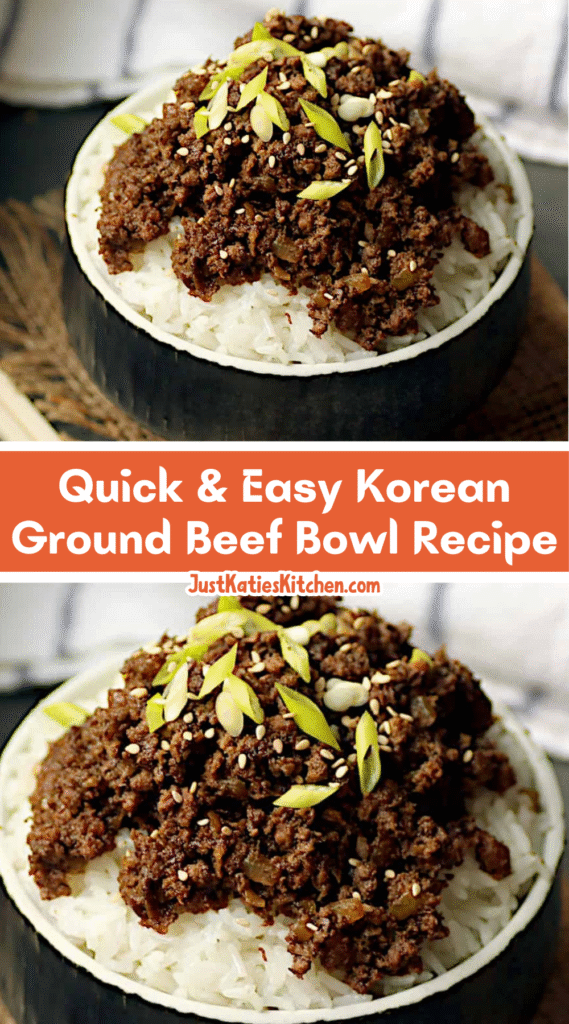
Let’s be real for a second. Some nights, you just need dinner to happen. Like, right now. You want something that feels like a hug in a bowl, something savory and a little sweet, with zero fuss. You do not want to spend the next hour wrestling with a mountain of dishes.
That’s where this Korean Beef Bowl swoops in to save the evening. It’s your weeknight superhero. Imagine tender, savory ground beef glazed in a sticky, gingery sauce, piled high on fluffy rice, and topped with a confetti of crisp, bright veggies. The best part? You’re about 20 minutes away from digging in.
This isn’t a fussy, authentic culinary endeavor. It’s inspired by the bold, comforting flavors we love, designed for your real life. It’s the kind of meal that makes everyone at the table happy, including the person who made it. So, let’s get to it.
Ingredients Needed for the Recipe
Gathering your lineup is the first step to success. Here’s what you’ll need to create this flavor explosion.
- Lean Ground Beef (93% lean): The hearty star of the show. Using lean beef means less greasy runoff, so your sauce stays clean and clings perfectly to every morsel.
- Low-Sodium Soy Sauce: The salty, umami backbone of the dish. Low-sodium is key here—it gives you control over the salt level, especially since the sauce reduces as it cooks.
- Scallions (Green Onions): Used two ways! The white and light green parts get cooked into the beef for a mild oniony punch, while the dark green tops are saved for a fresh, crisp garnish.
- Garlic: Because what’s a savory dish without it? Freshly minced is best for that potent, aromatic kick.
- Fresh Ginger: The zingy soulmate to garlic. Grating it fresh makes a world of difference, lending a warm, slightly spicy note that is absolutely irreplaceable.
- Rice Vinegar: A quick splash of acidity to balance the rich, sweet, and salty notes. It keeps the sauce from feeling too heavy.
- Honey: Our natural sweetener that creates that gorgeous, glossy glaze. It caramelizes slightly against the hot beef, building incredible depth.
- Red Pepper Flakes: Just a pinch for a gentle, warming heat. Feel free to dial this up if you like a little more fire in your life.
- Sesame Oil: The finishing touch! Stirred in at the very end, its distinctive, nutty aroma is the signature scent of so many amazing Asian dishes. Don’t skip it.
- For Serving: This is where you make it your own! Cooked brown rice, quinoa, or cauliflower rice. Plus, shredded carrots, thinly sliced cucumbers, and a sprinkle of toasted sesame seeds for that perfect crunch.
How to make Korean Beef Bowl?

Ready to see how fast this comes together? Follow these simple steps.
Step 1: The Quick Pickle (Your Secret Weapon)
If you have just five extra minutes, do this. Toss your shredded carrots and sliced cucumbers in a bowl with a splash of rice vinegar, a bit of water, a pinch of sugar, and salt. Let them hang out while you cook the beef. This brief bath makes them slightly pickled—tangy, crisp, and utterly transformative for your bowl.
Step 2: Brown the Beef
Crank a large skillet over medium-high heat and add your ground beef. Break it up with your spoon as it cooks. When it’s about halfway to being browned, toss in a tablespoon of the soy sauce and most of your scallions (save those green tops!). Once the beef is fully cooked, stir in the garlic for just 30 seconds until fragrant. Don’t let it burn!
Step 3: Whisk the Magic Sauce
While the beef is doing its thing, grab a small bowl. Whisk together the remaining soy sauce, rice vinegar, honey, that glorious fresh ginger, and the red pepper flakes. This is your flavor bomb, ready to deploy.
Step 4: Bring It All Together
Pour your sauce over the browned beef. Let it bubble away for about two minutes, stirring frequently. You’ll see it reduce slightly and coat the beef in a beautiful, shiny glaze. Take the skillet off the heat, and here’s the key: stir in the sesame oil. This preserves its delicate flavor.
Step 5: Build Your Masterpiece
Fluff your rice and divide it among bowls. Spoon a generous amount of the saucy beef over the top. Now, crown it with your quick-pickled veggies (drained), the reserved fresh scallions, and a generous shower of sesame seeds. Dig in immediately!
Best Time to Serve This Dish
This bowl is the ultimate versatile player. It’s the obvious hero of a hectic Tuesday night, when time is short but appetites are big. But don’t stop there.
It’s a fantastic meal-prep champion, tasting just as good on Thursday as it did on Monday. It’s also a surprisingly great dish for casual entertaining. Double the recipe, set out the components, and let friends build their own perfect bowls. It’s a guaranteed crowd-pleaser.
Ingredient Substitutions
No scallions? A bit of finely diced white onion cooked with the beef can work in a pinch. Out of honey? Maple syrup or even a little brown sugar will provide a similar sweetness. For a gluten-free version, simply swap the soy sauce for tamari.
If you want more heat, a teaspoon or two of gochujang (Korean chili paste) stirred into the sauce is a phenomenal upgrade. And if you’re not a beef person, ground turkey, chicken, or pork will all happily soak up these incredible flavors.
Tips
A few little secrets from my kitchen to yours can make your bowl even better.
- Mise en Place: This recipe moves fast. Have all your ingredients chopped, measured, and ready to go before you turn on the stove. It makes the process seamless and stress-free.
- Don’t Crowd the Pan: Use a large skillet to brown your beef. If the pan is too small, the beef will steam instead of getting those nice, crispy, browned bits that add so much flavor.
- Toasted Sesame Seeds: If you have raw sesame seeds, toast them in a dry pan over low heat for a few minutes until golden. It unlocks a deep, nutty flavor that elevates the entire dish.
How to Store and Reheat
Got leftovers? Fantastic. Store the completely cooled beef mixture separately from your rice and fresh toppings in airtight containers in the fridge. It will keep beautifully for up to 4 days.
To reheat, the stovetop is your best bet. Warm the beef in a skillet over medium-low heat with a tiny splash of water to loosen the sauce. The microwave works too—just heat in short bursts, stirring in between. The veggies are best enjoyed cold and crisp, so add them after reheating.
You can also freeze the cooked and cooled beef mixture for up to 3 months. Thaw it overnight in the refrigerator before reheating.
Flavor Variations
Once you’ve mastered the base, feel free to play around! Try adding a cup of small broccoli florets to the skillet when you add the sauce for a beef-and-broccoli situation. Sliced mushrooms would be a wonderful earthy addition, sautéed with the beef.
For a final, decadent touch, top your finished bowl with a perfectly fried egg with a runny yolk. When you break into it, the yolk becomes a rich, extra sauce that is downright magical. It’s a simple change that feels incredibly special.
Pairing Ideas
While this bowl is a complete meal on its own, a simple side can turn it into a feast. A light, crunchy Asian cucumber salad or a simple cabbage slaw provides a refreshing contrast to the savory beef.
If you’re serving a crowd, a plate of crispy, store-bought potstickers or spring rolls on the side never fails. And for a beverage, an ice-cold lager or a crisp, slightly sweet white wine like Riesling are perfect partners for the bold flavors.

Korean Beef Bowl Recipe
Description
With healthy ground beef, ginger, garlic, sesame oil, a touch of honey, and plenty of green onions, this Korean Beef Bowl recipe is perfect for serving over rice with vegetables for an easy, wholesome meal. The best part? It can be on your table in 20 minutes flat! Packed with bold Asian-inspired flavors, this dish is both satisfying and nutritious—ideal for weeknights or meal prep.
Ingredients
For the Beef
For Serving
Instructions
-
Pickling the Vegetables (Optional)
In a bowl, combine shredded carrots and sliced cucumbers with 2 tablespoons rice vinegar, 2 tablespoons water, ½ teaspoon sugar, and ½ teaspoon kosher salt. Let sit while you cook the beef to lightly pickle. Drain before using.Adds tang and crunch—highly recommended! -
Brown the Beef
In a large skillet over medium-high heat, brown the ground beef, breaking it into small pieces, for about 5 minutes. When halfway cooked, add 1 tablespoon of soy sauce and 2/3 of the scallions. -
Add Aromatics
Stir in the minced garlic and cook for 30 seconds until fragrant. -
Make the Sauce
While the beef cooks, in a small bowl, whisk together the remaining 2 tablespoons soy sauce, rice vinegar, honey, ginger, and red pepper flakes. -
Combine and Finish
Pour the sauce over the browned beef. Stir and cook for 2 minutes. Remove from heat and stir in the sesame oil. Top with the remaining green onions.Adjust seasoning with extra soy sauce or red pepper flakes if desired. -
Serve
Serve the beef hot over cooked rice or your preferred base. Top generously with pickled (or fresh) carrots, cucumbers, and a sprinkle of toasted sesame seeds.
Nutrition Facts
Servings 4
Serving Size 1 bowl
- Amount Per Serving
- Calories 420kcal
- % Daily Value *
- Total Fat 20gg31%
- Saturated Fat 7gg35%
- Trans Fat 0.5gg
- Cholesterol 75mgmg25%
- Sodium 680mgmg29%
- Potassium 650mgmg19%
- Total Carbohydrate 32gg11%
- Dietary Fiber 4gg16%
- Sugars 12gg
- Protein 28gg57%
- Calcium 8% mg
- Iron 25% mg
* Percent Daily Values are based on a 2,000 calorie diet. Your daily value may be higher or lower depending on your calorie needs.
Note
- Gluten-Free Option: Use tamari instead of soy sauce.
- Veggie Swap: Try broccoli, bell peppers, or mushrooms.
- Spice It Up: Add 1 tsp gochujang or sriracha to the sauce.
- Meal Prep: Store components separately for up to 4 days. Assemble before eating.
- Protein Swap: Ground turkey, chicken, or pork work well too.
Frequently Asked Questions
Can I make this Korean Beef Bowl gluten-free?
Yes! Simply substitute low-sodium soy sauce with gluten-free tamari or a certified gluten-free soy sauce.
Can I use a different protein instead of ground beef?
Absolutely. Ground turkey, chicken, or pork are great alternatives. For a more traditional bulgogi-style dish, thinly sliced beef can be used, though cooking time may vary.
How do I store and reheat leftovers?
Store in an airtight container in the refrigerator for up to 4 days. Reheat gently in a skillet over medium-low heat or in the microwave. Add a splash of water or broth to keep moist.
Can I freeze this dish?
Yes. Freeze the beef mixture and vegetables in a freezer-safe container for up to 3 months. Thaw overnight in the fridge before reheating.
What are the best sides to serve with this bowl?
Try steamed broccoli, Asian Cucumber Salad, Air Fryer Tofu, or a simple green salad. Lettuce wraps are also a fun, low-carb option.

